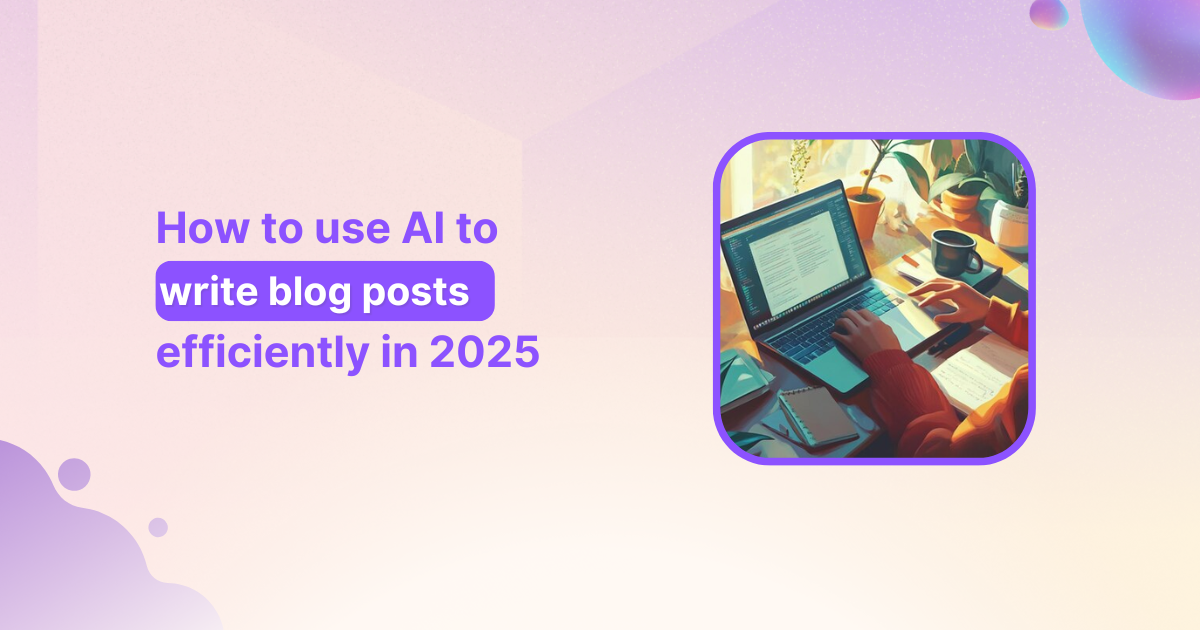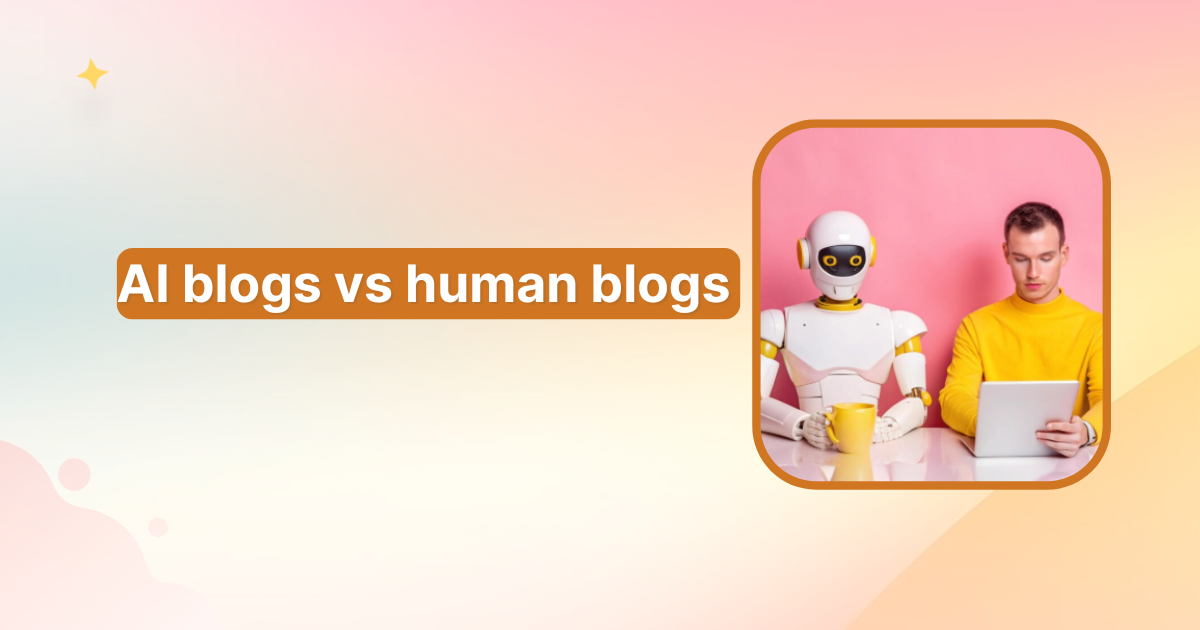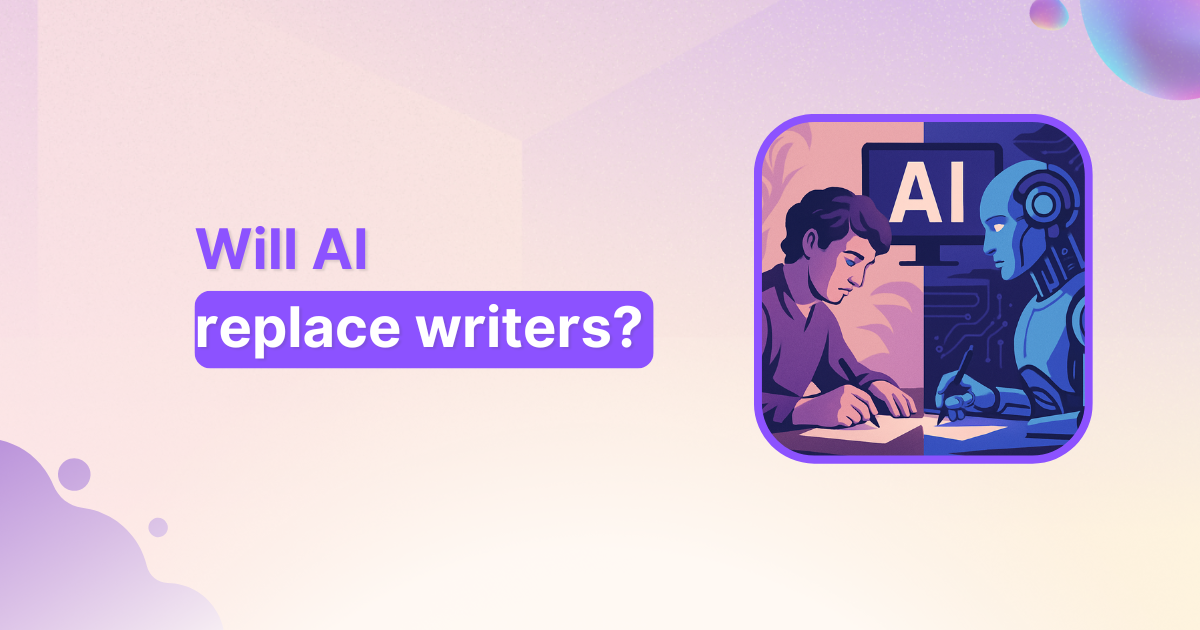How to use AI to write blog posts efficiently in 2025

These days, almost everyone has access to AI tools or AI blog writers. But having AI at your fingertips doesn’t automatically make you a better writer.
The real advantage comes from knowing how to use AI the right way – choosing the best tools, applying the right techniques, and blending AI’s efficiency with your unique voice.
While AI can speed up the writing process, relying on it without a clear strategy often leads to content that feels generic or lacks personality.
That’s why it’s essential to know which AI tools are best for blog writing, how to guide them with clear prompts, and when to refine the output to make it your own.
Today, we’ll cover practical strategies to help you understand how to use AI to write blog posts- from selecting the right platform to using techniques that make your content engaging, authentic, and SEO-friendly.
Let’s dive in and see how you can create blog posts that capture attention and deliver value – without losing the personal touch that makes your writing unique.
Key takeaways
- Efficiency & scalability: AI significantly reduces the time and cost associated with blog post creation, allowing for increased content output.
- Quality & consistency: With proper prompt engineering and human editing, AI can produce high-quality, consistent content that aligns with your brand voice.
- SEO optimization: AI tools assist in keyword optimization, headline generation, and image optimization, enhancing your blog’s search engine visibility.
- Content authenticity: While AI is a powerful tool, maintaining originality and authenticity requires human oversight, including fact-checking and personalization.
- Strategic implementation: Successful AI blog writer tool involves a clear content strategy, effective prompt creation, and a thorough editing process.
- Tool selection: Choosing the right AI tool is vital, Contentpen provides many features that assist greatly in the creation of AI blog posts.
- Human touch is vital: AI is a tool, not a replacement. Human editing and brand voice implementation is critical.
Why you need to use AI to write blog posts in 2025?
The demand for fresh, engaging content is higher than ever. According to a 2023 report by HubSpot, businesses that publish 16+ blog posts per month generate 3.5x more traffic than those that publish fewer than four. However, creating this volume of content manually is time-consuming and expensive.
AI writing assistants like Contentpen are designed to streamline the process, enabling you to produce high-quality blogs in a fraction of the time. By 2025, it’s estimated that most businesses will use AI tools for content creation, making it essential to adopt this technology now to stay competitive.
The evolution of blog content creation
Gone are the days when blog writing was solely a manual process. With advancements in natural language processing (NLP) and machine learning, AI tools can now generate coherent, engaging, and SEO-friendly content.
For example, Contentpen uses cutting-edge AI to assist with everything from brainstorming ideas to crafting full-length articles. This evolution has not only made content creation faster but also more accessible to non-writers.
Time and cost analysis: Traditional vs. AI-assisted writing
Creating blog posts can be both time-consuming and costly, especially when relying on traditional methods. With AI-assisted tools like Contentpen, businesses can streamline the writing process without sacrificing quality. Here’s a quick comparison:
| Aspect | Traditional writing | AI-assisted writing |
| Time per blog post | Approximately 4-6 hours. A study by MIT researchers found that professionals using traditional methods took longer to complete writing tasks. Source | Approximately 1-2 hours. The same MIT study reported that participants using AI tools completed tasks 40% faster. Source |
| Cost per post (freelance) | $500 – $5,000. According to a Deloitte report, the average cost for producing a single piece of high-quality content using traditional methods can range significantly based on complexity and requirements. Source | Up to 60% reduction in costs. A 2021 report by Market Research Future estimates that businesses utilizing AI for content creation can reduce costs by up to 60%. Source |
| Consistency | Varies by the writer. Traditional methods rely heavily on individual writer’s style and consistency. | High consistency with proper prompts. AI tools can maintain a consistent tone and style across content pieces when guided effectively. |
| Scalability | Limited scalability due to human resource constraints. | Highly scalable. AI tools can generate large volumes of content quickly, facilitating rapid scaling. |
These findings suggest that AI-assisted writing tools can significantly enhance productivity and reduce costs while maintaining or improving content quality.
On the other hand, AI-assisted writing speeds up the process, reducing the time needed to produce an AI blog post to just 1-2 hours. With tools like Contentpen, the cost per post also drops significantly, making it a cost-effective solution for businesses looking to scale their content production.
Plus, with the right prompts, AI can maintain a consistent tone and style across all your content, ensuring a cohesive brand voice.
08 essential steps to write blog posts with AI
Writing blog posts with AI involves a series of essential steps to ensure the content is engaging, SEO-friendly, and aligned with your brand voice.
AI-assisted blogs can save time, reduce costs, and improve productivity while maintaining high quality. The following steps outline how to effectively leverage AI tools like Contentpen for blog writing.
1. Select the right AI tool
Choosing the right AI writing tool is essential for creating high-quality content that meets your goals. Look for a platform that offers robust features such as SEO optimization, tone customization and versatile content generation such as Contentpen.
Contentpen is a great choice, known for its user-friendly interface, advanced AI capabilities, and ability to produce engaging, well-structured content quickly.
It integrates seamlessly with your workflow, supports collaboration if needed, and enhances productivity by automating time-consuming writing tasks.
2. Conduct research and prepare key details
Thorough research is crucial for creating relevant and engaging content. Start by identifying your target audience and understanding their preferences, pain points, and interests. Gather essential keywords to optimize your content for search engines and align with your SEO strategy.
Clearly define your content objectives – whether it’s to inform, persuade, or drive conversions – to ensure the AI generates content that meets your goals.
Outline the main points, structure, and tone of your blog post to provide the AI with a clear framework. This includes defining the introduction, key sections, and conclusion to maintain coherence and readability.
3. Craft clear and detailed AI prompts
The quality of AI-generated content depends on the prompts you provide. Be specific and include key details such as:
- Target audience: Define who the content is for.
- Tone and style: Specify if the tone should be professional, conversational, or playful.
- Main points: Highlight essential topics to cover.
For example, instead of saying, “Write a blog about AI,” use a detailed prompt like:
“Write a 1,000-word blog post for small business owners on how AI can improve productivity. Focus on cost-effective tools like Contentpen, with practical examples and tips.”
4. Edit and refine AI-generated content
While AI-generated drafts provide a solid foundation, refining them ensures your content resonates with your audience and aligns with your brand identity. Use Contentpen’s editing features to enhance and personalize the content:
- Adjust tone and style: Tailor the language, tone, and style to match your brand’s voice, whether it’s professional, conversational, or authoritative.
- Add personalization and examples: Strengthen engagement by incorporating personal anecdotes, real-life case studies, or industry-specific examples that showcase expertise and credibility.
- Ensure accuracy and credibility: Verify facts, statistics, and references to maintain reliability and build trust with your readers.
This combination of AI efficiency and human creativity results in high-quality content that is both engaging and authentic.
5. Optimize keywords naturally
Effective keyword integration is crucial for both search engine visibility and reader engagement. AI tools like Contentpen analyze your content to identify keywords that align with user intent and search engine algorithms.
Unlike traditional manual research, AI ensures that keywords are seamlessly woven into your text without overstuffing – enhancing readability while improving search rankings.
For example, if your blog focuses on “AI productivity tools,” You can provide Contentpen related long-tail keywords such as “affordable AI tools for small businesses” or “boost productivity with AI automation.” This strategic use of keywords not only attracts search traffic but also ensures your content remains natural, engaging, and valuable to readers.
6. Write click-worthy headlines and meta descriptions
Headlines and meta descriptions are essential for attracting clicks from search results, so they must be both compelling and clear. AI tools can generate multiple headline variations, allowing you to choose the most attention-grabbing option while ensuring it aligns with your content’s purpose.
For example, if you’re writing about “AI productivity tools,” AI might suggest headlines like “Boost Your Productivity with AI Tools: Top Picks for 2024” and meta descriptions like “Discover the best AI productivity tools to streamline your workflow, save time, and boost efficiency for your business.” This combination enhances both search visibility and user engagement.
7. Optimize images for SEO and speed
Visual elements not only enhance user engagement but also play a vital role in SEO. AI tools like Contentpen help optimize your images by:
- Generating descriptive alt text: AI suggests alt text that accurately describes your images, improving accessibility and making your visuals more discoverable in search engine image results. For example, instead of “AI tool screenshot,” AI might recommend “Dashboard of AI productivity tool showcasing automated task management.”
By combining engaging visuals with optimized SEO practices, you can boost both user engagement and search engine performance.
8. Build a strong internal linking structure
Internal linking is essential for both SEO and user engagement. It helps search engines crawl your site more efficiently while encouraging readers to explore related content. AI tools like Contentpen can scan your content and automatically add relevant internal links that align with your topic and keywords.
For example, if you’re writing about “AI content creation,” AI might recommend linking to posts such as “AI productivity hacks” or “Choosing the Right AI Writing Tool.”
By strategically linking to blog posts, landing pages, or product pages, you not only improve your site’s SEO performance but also guide readers through your content ecosystem, increasing time spent on your website.
Transform your content creation with Contentpen
Creating high-quality content consistently can be challenging, but Contentpen makes the process faster and more efficient. Whether you’re drafting blog posts, social media captions, or website copy, this AI-powered tool streamlines your workflow, saving you time while maintaining quality.
How Contentpen streamlines the writing process
From brainstorming ideas to hitting publish, Contentpen simplifies every step of content creation. Its intuitive interface is easy to navigate, making it perfect for beginners, while its advanced features cater to the needs of seasoned writers. With AI-driven suggestions and real-time feedback, you can focus more on creativity and less on tedious tasks.
Smart features that set Contentpen apart
Contentpen offers a suite of powerful features designed to elevate your writing:
- AI article generation: Quickly create SEO-optimized articles using AI. Simply provide a primary keyword, topic, and choose from preset templates to generate engaging content.
- Bulk article generation: Save time by generating multiple articles at once. Add multiple rows with different keywords and topics, then generate them in a single click.
- Internal & external link suggestions: Automatically add relevant internal and external links to improve both SEO and user experience.
- Image generation with alt text: Generate and insert images complete with alt texts, enhancing both visual appeal and accessibility.
- Feature image addition: Automatically add feature images to make your content visually engaging from the start.
- Brand voice customization: Ensure consistency in your content by aligning with your brand’s unique tone of voice. Adjust the writing style to match your desired formal, conversational, or playful tone.
- Content presets: Choose from various presets to generate content tailored to specific needs, ensuring each article fits the intended purpose and platform.
- Knowledge base integration: Incorporate information from your knowledge base to generate accurate and contextually relevant content.
- Planner: Stay organized with a built-in content planner that helps you schedule and manage your content pipeline efficiently.
- Collaboration tools: Easily collaborate with team members by inviting them to the platform, streamlining the review and editing process.
- “Ask AI” feature: Add AI-generated prompts directly within your draft, allowing quick additions or modifications wherever needed.
Additionally, Contentpen includes SEO optimization features such as:
- SEO score tracking: Monitor your content’s SEO score with a visual grade indicator to ensure it’s optimized for search engines.
- Keyword optimization: Ensure primary and secondary keywords are used effectively.
- Meta details optimization: Optimize meta titles and descriptions to improve search visibility.
- Technical SEO factors: Ensure your content meets technical SEO best practices.
- User engagement elements: Enhance the user experience by adding engaging elements like CTAs, interactive content, and visuals.
Starting with Contentpen is quick and straightforward:
- Select the Generate Article with AI template.
- Enter your primary keyword and topic.
- Choose a preset that suits your content style.
- Click Generate Articles and let AI do the work.
Within seconds, you’ll have a draft ready for review. Enhance it with internal and external links, adjust the tone to match your brand voice, and add media assets for a polished, professional post.
Easily share your draft with your team by adding members to collaborate in real-time. Whether you need a single blog or multiple articles in bulk, Contentpen helps you deliver engaging content with ease.
Quality assurance for AI-written content
Ensuring the quality of AI-generated content is crucial for maintaining credibility, readability, and engagement. While AI tools can streamline the writing process, human oversight is essential to ensure accuracy, originality, and alignment with your brand voice. Let’s explore key techniques to maintain high-quality content.
Ensuring authenticity and compliance
- Use AI detection tools like Originality.ai to verify content doesn’t appear automated
- Incorporate unique insights and personal examples to enhance readability
- Maintain a natural flow with diverse sentence structures
Refining content with human expertise
- Verify facts and statistics for accuracy
- Simplify complex sentences and remove jargon
- Add personality with unique voice and conversational elements
- Integrate keywords naturally for SEO integrity
Maintaining consistency
- Use tools like Google Docs or Notion to organize and label drafts
- Document major edits and feedback
- Analyze engagement metrics to refine future content
Content authenticity checklist
- Fact-check all information using reliable sources
- Ensure originality with plagiarism checkers (Grammarly, Copyscape)
- Add unique insights and personal experiences to differentiate your content
Common mistakes to avoid
- Over-relying on AI without human refinement
- Using vague prompts instead of specific, detailed ones
- Neglecting to add personal judgment and creativity
By combining AI efficiency with human creativity, you’ll create content that’s both engaging and credible.
Conclusion
Using AI to write blog posts is no longer a futuristic concept – it’s a game-changing reality that’s transforming content creation. By integrating tools like Contentpen into your workflow, you can streamline the writing process, reduce costs, and consistently produce high-quality, SEO-optimized content that resonates with your audience.
Ready to elevate your blogging experience? Sign up for Contentpen today and experience the future of content creation!
FAQs on AI blog writing
AI blog writing uses machine learning algorithms to generate content based on user inputs. Tools like Contentpen analyze prompts and produce coherent, engaging articles.
Costs vary, but AI tools like Contentpen are significantly more affordable than hiring freelance writers.
No, AI is a tool to assist writers, not replace them. Human creativity and oversight remain essential.
Search engines focus on content quality, not its origin. Ensure your content is valuable and well-optimized.
With tools like Contentpen, you can create a blog post in 1-2 hours, including editing.
No, AI tools are designed to be user-friendly for both beginners and experts.
Contentpen offers SEO optimization, tone customization, and smart editing features to enhance content quality.
You can create a wide range of content, including how-to guides, listicles, case studies, and more.
You might be interested in...

Is AI the future of blog writing services?
Traditional blog writing services face their biggest disruption yet. With generative AI tools producing content in seconds, businesses are questioning whether they still need human writers. AI writing tools have transformed from niche curiosities to mainstream business solutions practically overnight. Content agencies report a common refrain from clients: “Why should we pay for human writers […]
Aug 5, 2025

AI blogs vs human blogs: Which creates better content in 2025?
The debate between AI blogs vs human blogs has reached a tipping point. With AI tools for content creation becoming more popular and advanced, businesses are questioning whether they should stick with human writers or embrace artificial intelligence for their content strategy. Studies indicate that 88% of marketers are already relying on AI to handle […]
Jul 14, 2025

Will AI replace writers? The truth behind the hype
The digital landscape is buzzing with excitement and anxiety about AI writing tools. From Contentpen’s intelligent content generation to ChatGPT’s conversational prowess and Jasper’s marketing copy expertise, artificial intelligence has stormed into the writing world with impressive capabilities. This technological leap forward has sparked a burning question that keeps writers awake at night: Will AI […]
Jun 19, 2025